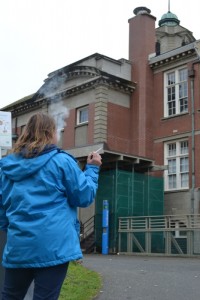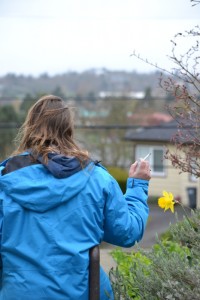Smoking in Victoria is about to become a lot more difficult. The Capital Regional District (CRD), in collaboration with Island Health (VIHA), has updated the existing Clean Air Bylaw, which currently prohibits smoking three metres from businesses, patios, and bus stops.
The CRD is a government-regulated organization comprised of elected members representing the multiple municipalities on South Vancouver Island, including Esquimalt, Saanich, Duncan, and Sooke. VIHA is also regulated by the government and has collaborated with the CRD to enforce the new bylaw in the interest of public health.
As of April 1, Clean Air Bylaw No. 3962 will include a complete smoking ban in public parks, playgrounds, sports fields, and public squares, with an increased buffer zone of seven metres from business entrances and air intakes.
Bus stops, while already smoke-free, will now have a seven-metre buffer zone measured from the transit pole. The bylaw, which bans the use of tobacco indoors, doesn’t apply to traditional aboriginal cultural activities and events, where tobacco may be burned ceremonially. The bylaw was originally passed September 10, 2014 by the CRD.

“Our goal is to keep rates of smoking as low as possible in the region,” says Eric Berndt, communications officer for Island Health, iterating that the bylaw isn’t intended to ostracize smokers, although it is designed to encourage them to quit.
“The bylaw is an opportunity to let everyone know there are free resources available to anyone looking to quit,” says Berndt. “Any resident of BC can call 811 and access nicotine-replacement therapy free of charge if they’d like to quit.”
Although 70 percent of smokers are looking to quit, according to Berndt, there are worries that the bylaw is underestimating the difficulty of overcoming a smoking addiction, and assuming that wanting to quit means being ready to quit.
Also, low-income individuals and homeless who smoke may not be aware of the new bylaw and could be restricted in their access to online resources provided by VIHA and the CRD.
Enforcement and consequences
While repeat offenders can be fined up to $2,000 for violating the new bylaw, there’s likely to be a more progressive approach taken to enforcement.
The Vancouver Island Health Authority, in conjunction with Tobacco Enforcement Officers, will be responsible for enforcing the bylaw while citizens adjust to the new rules. As with the previous bylaw prohibiting smoking indoors and on patios, the hope is that citizens will politely conform to the new restrictions. Tickets will be a last resort for non-compliant individuals with multiple complaints against them and for repeat offenders.
“After observations or investigation by a Tobacco Enforcement Officer, there might be a verbal warning. Second, we could write a written warning. If the person still did not comply we would issue a ticket fine,” says Berndt, hoping smokers will acknowledge the bylaw and police themselves. “To give a bit of context, in the past five years under the previous Clean Air Bylaw there was one ticket issued, for $50.”
As with the previous bylaw, police won’t be involved in enforcing the new provisions. However, individuals who witness a violation of the bylaw can contact Tobacco Enforcement with their complaint at 250-360-1450.
Non-smoking areas will be equipped with proper signage to inform smokers where they can and cannot light up. It’s unclear how visually impaired smokers will be informed of non-smoking areas.
Smoking and students
Many Camosun students aren’t pleased with the new bylaw, even those who have recently quit. Many feel as though it is effectively stonewalling smokers into quitting by making lighting up virtually impossible.
“Smokers have become increasingly marginalized, despite making up a large portion of society. Yet no smokers will dispute the increasing restrictions because they’ve been effectively shamed into submission,” states first-year Public Administration student and ex-smoker Megan Greentree. “It’s outrageous to prohibit smoking in a big, open area, where people would literally have to walk into a smoker’s space to be subjected to secondhand smoke. One of the biggest sources of air pollutants is transportation: is the CRD going to crack down on driving vehicles? I think not. Smokers are an easier target.”
The bylaw states environmental secondhand smoke (residual smoke lingering in areas after a cigarette has been extinguished) as a target to eliminate.
First-year Bachelor of Athletic and Exercise Therapy student Dean Sipos says that while he does agree with some provisions of the bylaw, he finds them too harsh. As an ex-smoker, he knows making the decision to quit is a difficult and lengthy process, even when one is ready.
“It alienates people who smoke and makes them feel like a dirty smoker,” says Sipos. “I am in full agreement with smoking seven metres away from business doorways, windows, and air intakes. This is simply because a business has a certain image to keep up and when smoke enters a building, it cannot disperse as easily as outside.”
Berndt, while empathetic to students’ concerns, says that the bylaw is meant to benefit everyone.
“The bylaw is not designed to accommodate smoking habits. It is intended to reduce the incidence of secondhand smoke and encourage people to quit smoking,” says Berndt. “Bylaws such as the CRD’s Clean Air Bylaw are intended to protect and promote health and safety for all citizens. There is no safe level of secondhand smoke.”
Others fear the new bylaw will effectively shut off the downtown core from smokers, especially those who work and participate in the city’s nightlife, such as clubs and bars. VIHA was unclear on the options available for these individuals, as previous popular smoking spot Beacon Hill Park will become a no-smoking area.
“Tack on a few more bylaws and it will be effectively impossible to smoke anywhere in public,” says Greentree. “I think the city has begun its descent into the criminalization of smoking.”
While Berndt couldn’t comment on whether designated smoking areas in Beacon Hill may be a possibility, he urges smokers to pursue other avenues to cope with the new bylaw.
“We would encourage people to take advantage of the resources available to help you quit,” says Berndt, referencing the programs directed towards smokers such as QuitNowBC.
Some students feel as though the new bylaw is a case of “it takes one to ruin it for everyone,” with inconsiderate smokers lighting up in inappropriate locations bringing negative attention to the habit.
While many smokers opt to smoke away from public, it’s not uncommon for some to light up under bus shelters if it’s raining, or on patios if they have purchased food at an establishment. The students noted that open spaces such as parks and fields were ideal, as their secondhand smoke could disperse easily.

“When smoking outside in an open area, I feel it does little to nothing to affect people’s health who are in the vicinity,” says Dean Sipos, who as an ex-smoker notes that he would always make sure he was away from children and groups of people when he smoked.
This seems to be a running commentary amongst Camosun students. Greentree, who currently uses a vaporizer, concurs with Sipos, stating that most smokers understand the implications of their habit.
“I would argue that most smokers are conscientious about where they light up. You’ll notice most smokers already stand as far away from bus stops as possible. It’s rude to smoke in business doorways, and I think most smokers would agree with me,” says Greentree, frustrated that the bylaw aims at forcing smokers to quit, rather than allowing individuals to make an informed decision. “The inconsiderate smokers who light up in congested public spaces are simply inconsiderate people.”
Daniel Reeve, chair of Camosun’s Social Sciences Department, notes that most students who smoke are conscious of the dangers, but the bylaw is in congruence with changing social attitudes towards smoking.
“Most students know that smoking poisons the body,” says Reeve. “They may not know, however, that there is a demographic tendency that links the likelihood of smoking with education levels. The highest percentage of smokers in Canada are, statistically, the least well educated. The smallest percentage of smokers are those with a degree. Smoking rates in North America have been in decline since the 1980s, yet youth smoke at the highest rate of any section of the population. If the bylaw discourages youth smoking, I’m for it.”
Targeted ban?
As mentioned by Berndt, the bylaw is aimed at targeting youth smokers in order to project a healthier image on children. While the highest incidence of smoking in Canada occurs in youth aged 24 to 35, this statistic declines as individuals attend postsecondary and earn degrees.
In this respect, the bylaw fails to address older, long-term smokers who also have an impact on youth, including family members and community members such as coaches and teachers.
Reeve’s statistics are in line with a University of Waterloo study, which notes that smoking prevalence varies greatly between education levels. It also notes that the majority of smokers smoke daily rather than casually.
With the bylaw effectively shutting off the downtown core for smokers, the bylaw seems to forget the large population of homeless, low-income, and indigenous individuals who access resources such as the Victoria Cool Aid Society and shelters. Many of these individuals use smoking as a method to cope with their situation, and forcing them out of the downtown core may be an accidental consequence of the new bylaw.
The previous bylaw targeted patrons of businesses and high traffic areas, which may be why the low-income demographic has been forgotten in the new bylaw.
While education and awareness are an appropriate route for targeting youth smoking, there’s the issue of awareness amongst individuals who don’t own media devices, such as the homeless.
It’s unclear what the response to the updated Clean Air Bylaw will be, but some speculate it may run along the lines of backlash against the criminalization of marijuana, with low enforcement meaning many individuals will simply continue smoking. The added difficulty associated with the addictive properties of nicotine means simply putting down the pack and quitting is not as easy as the bylaw seems to assume.
The response to the Clean Air Bylaw is yet to be observed, and while many hope for a measurable decline in smoking in the Capital Regional District, it may provoke an unforeseen backlash in the community. Still, Island Health’s Berndt remains optimistic that it is a step in the right direction.
“We have a high rate of compliance for smoking bylaws in the CRD,” he says, “and we believe, over time, the same will be true for the current Clean Air Bylaw.”
